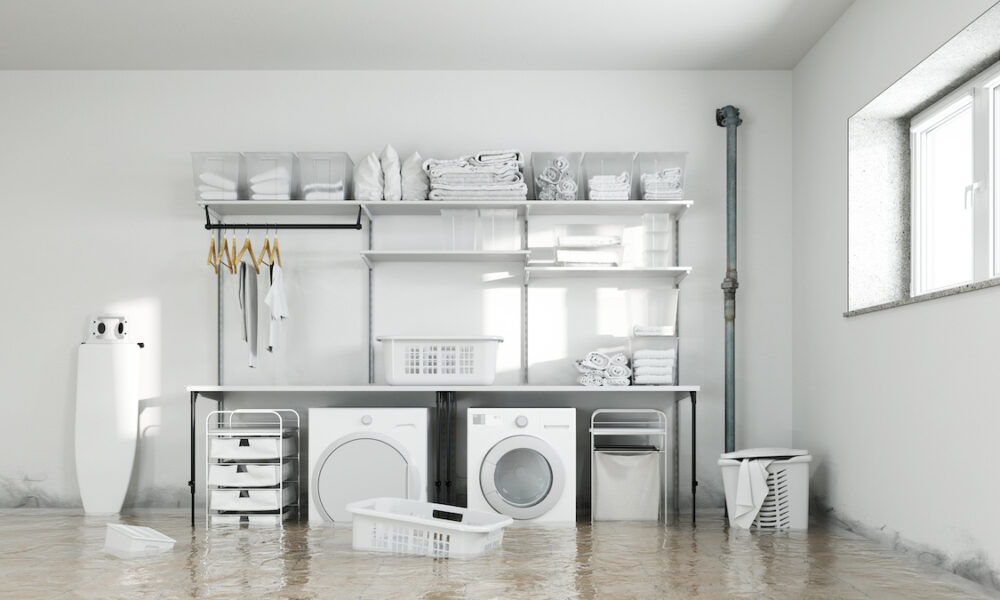
Basement floods can be a homeowner’s nightmare, causing significant damage and disruption. Whether it’s due to heavy rainfall, burst pipes, or other unforeseen circumstances, a flooded basement requires swift and systematic action to minimize the extent of the damage and restore your home to a safe and habitable condition.
In this blog, we’ll walk you through the essential checklist for a basement flood clean-out, covering everything from immediate response to thorough restoration. If you find yourself overwhelmed or in need of professional assistance, Just Rubbish Removal is here to provide efficient and reliable solutions for your basement flood clean-out needs.
An Immediate Response to a Basement Flood
The importance of an immediate response to a flooded basement cannot be overstated. Time is of the essence when dealing with water intrusion, as every passing moment increases the risk of extensive damage and long-term consequences. Swift action is crucial to prevent further water infiltration, mitigate structural damage, and salvage belongings. Immediate response helps minimize the growth of mold and bacteria, which can pose serious health risks and compromise indoor air quality.
Additionally, addressing the situation promptly aids in preventing electrical hazards, as water exposure can compromise wiring and electrical systems. By acting swiftly, homeowners not only protect the integrity of their homes but also reduce the emotional and financial burdens associated with prolonged water damage. Timely intervention sets the foundation for an effective cleanup and restoration process, ultimately ensuring a safer and more expedited return to a normal living environment.
Ensure Safety First
Before entering a flooded basement, prioritize safety. Turn off the electricity to the affected area to reduce the risk of electrical hazards. If the water level is high or if there is any doubt about the safety of the environment, wait for professional assistance.
Identify the Source
Determine the source of the flooding to prevent further damage. If the flood is caused by a burst pipe, shutting off the main water supply is crucial. In the case of heavy rainfall, ensure that the external sources of water entry are addressed.
Remove Standing Water
Use a submersible pump, a wet/dry vacuum, or buckets to remove standing water from the basement. The sooner you extract the water, the less damage it will cause to the structure and contents.
Salvage Valuables
While removing water, salvage any valuables or important documents that may be at risk. Be cautious of contaminated water, and prioritize items that can be sanitized and saved.

Cleaning and Disinfecting During a Basement Flood Clean-Out
Cleaning and disinfecting after a basement flood is of paramount importance for several critical reasons. Floodwaters often carry contaminants and bacteria that can pose serious health risks if not properly addressed. Thorough cleaning removes visible debris, silt, and potential pollutants, while disinfection with appropriate agents helps eradicate harmful microorganisms. This not only prevents the spread of waterborne diseases but also safeguards indoor air quality.
Moreover, prompt cleaning and disinfecting significantly reduce the risk of mold growth, a common consequence of water damage. Mold can proliferate rapidly, leading to respiratory issues and structural damage. Addressing these concerns immediately not only ensures a safer and healthier living environment but also minimizes the long-term impact of a basement flood on both the structure and the well-being of the occupants.
In essence, the meticulous cleaning and disinfection of a flooded basement are vital steps in the comprehensive restoration process, contributing to the overall safety and resilience of the affected space.
Here are just a few tips for cleaning and disinfecting during a basement flood.
Get Rid of Contaminated Items
Dispose of items that cannot be adequately cleaned or disinfected. This includes porous materials like carpets, upholstered furniture, and certain types of insulation that may harbor mold and bacteria.
Clean and Disinfect All Surfaces
Thoroughly clean and disinfect all surfaces affected by the floodwater. Use a mixture of bleach and water to sanitize walls, floors, and any salvageable items. This step is crucial for preventing mold growth and ensuring a safe environment.
Inspect and Clean HVAC Systems
Check heating, ventilation, and air conditioning (HVAC) systems for damage and clean or replace filters. Floodwater can carry contaminants that affect indoor air quality, so a thorough inspection of these systems is essential.
Address Mold Concerns Quickly
Watch for signs of mold growth and address them promptly. Mold can start to develop within 24-48 hours of water exposure, so it’s crucial to act quickly to prevent further damage and potential health risks.
Review the Structure of Your Home
Reviewing the structure of your home after a basement flood is a crucial step in ensuring its long-term stability and safety. Floodwaters can compromise the structural integrity of the:
- Foundation
- Walls
- Flooring
- Electrical systems
Identifying and addressing any damage promptly is essential to prevent further deterioration that could lead to costly repairs or even structural failure. Waterlogged materials, if not promptly replaced, can become breeding grounds for mold and pose health risks to occupants.
A thorough structural assessment allows homeowners to identify potential issues early on, enabling them to take necessary measures for repairs and reinforcement. By prioritizing this step, homeowners not only protect the structural soundness of their homes but also contribute to the overall well-being and longevity of the living space, ensuring a safe and resilient environment for years to come.
Here are a few tips for reviewing the structural integrity of your home after a basement flood.
Inspect Foundation and Walls
Examine the basement’s foundation and walls for any structural damage. Cracks, bulges, or other signs of compromise should be addressed promptly to prevent long-term issues.
Check Electrical Systems
Have a qualified electrician inspect the electrical systems in the basement to ensure they are safe to use. Water damage can compromise wiring and pose a significant risk if not properly addressed.
Assess Flooring and Drywall
Evaluate the condition of flooring and drywall. Water-damaged materials may need to be replaced to prevent mold growth and structural issues.
Moisture Control After a Basement Flood
Moisture control after a basement flood is extremely important for preventing long-term damage and ensuring a safe, habitable environment. Excess moisture, if left unaddressed, creates an ideal breeding ground for mold and mildew, which can proliferate rapidly and pose serious health risks.
Implementing effective moisture control measures, such as using dehumidifiers and improving ventilation, helps expedite the drying process and inhibits the growth of mold.
Lingering moisture not only jeopardizes the structural integrity of the home but also contributes to the deterioration of materials, leading to potential issues like rot and decay. By promptly managing moisture levels, homeowners:
- Mitigate the risk of secondary damage
- Protect their investment in the property
- Foster a healthier indoor environment for themselves and their families
Here are a few tips for moisture control after a basement flood.
1. Use Dehumidifiers
Deploy dehumidifiers to control humidity levels in the basement. This is crucial for preventing mold growth and ensuring that the space is thoroughly dried out.
2. Improve Ventilation
Enhance ventilation in the basement by opening windows and using fans. Proper airflow accelerates the drying process and reduces the risk of lingering moisture.
3. Waterproofing Measures
Consider implementing waterproofing measures to prevent future basement floods. This may include sealing cracks, installing sump pumps, and improving drainage systems around your home.

Are you Seeking Professional Basement Flood Clean-Out Assistance?
If the basement flood damage is extensive, or if you’re overwhelmed by the cleanup process, it’s advisable to seek professional assistance. Professionals have the expertise, equipment, and experience to handle large-scale clean-outs effectively.
Just Rubbish Removal – Your Basement Flood Clean-Out Solution
Just Rubbish Removal is a trusted name in professional cleanup and removal services, dedicated to assisting homeowners in Brooklyn, Queens, Bronx, Manhattan, or Staten Island in the aftermath of disasters like basement floods. With a team of experienced professionals, we specialize in efficient and thorough clean-out services.
Our approach to basement flood clean-outs is comprehensive and tailored to the unique needs of each client. We prioritize efficiency, safety, and sensitivity to the challenges homeowners face in the aftermath of a flood. No matter the extent of the clean-out, we are here to help.
Why Choose Us Just Rubbish Removal for a Basement Flood Clean-Out?
Choosing Just Rubbish Removal means choosing a reliable partner committed to restoring your home to a clean and safe condition. Our team is equipped with the necessary tools and expertise to handle the complexities of basement flood clean-outs, ensuring a seamless and stress-free process for our clients.
A basement flood can be a daunting experience, but with a systematic approach and the right resources, you can effectively navigate the cleanup and restoration process. Following this essential checklist will guide you through the crucial steps of:
- Immediate response
- Cleaning
- Structural assessment
- Moisture control
- Seeking professional assistance when needed
If you require expert help with your basement flood clean-out, Just Rubbish Removal is ready to provide efficient and reliable solutions, ensuring that your home is restored to a safe and habitable state.



